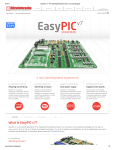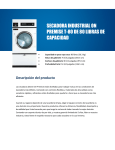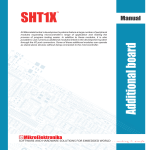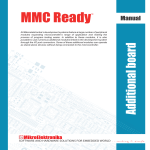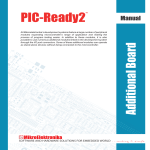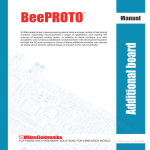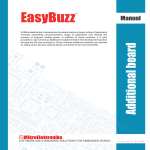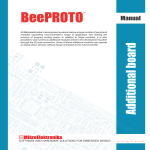Download EasyBee Board User Manual
Transcript
All Mikroelektronika’s development systems feature a large number of peripheral modules expanding microcontroller’s range of application and making the process of program testing easier. In addition to these modules, it is also possible to use numerous additional modules linked to the development system through the I/O port connectors. Some of these additional modules can operate as stand-alone devices without being connected to the microcontroller. Manual Additional Board EasyBee ™ MikroElektronika EasyBee Additional Board The EasyBee additional board is used for wireless communication between a development system and a device. Wireless communication is enabled due to a ZigBee™ module operating at 2.4GHz and in compliance with the IEEE 802.15.4 standard. Key features: - ZigBee transceiver operates in compliance with the IEEE 802.15.4 standard; - 2.4GHz operating frequency; - 5V or 3.3V power supply voltage; and - capable of connecting with various development systems. How to connect the board? Connection between the additional board and a microcontroller is established via a 2x5 connector supplied on the additional board and a 2x5 connector on the development system, Figure 2. Communication between them is performed via a serial UART connection. There are also six pads provided on the additional board which enable direct access to the UART pins RX, TX, RTS and CTS. These pads can also be used to connect the USB UART board, which enables the EasyBee board to be connected to the USB port of the PC and used over the UART Terminal software. Pads ZigBee module Figure 1: EasyBee additional board A Figure 2: Connecting additional board B Figure 3: Power supply selection How to use the board? The additional board is powered via a development system it is connected to. In case the additional board is connected to a 5V development system, it is necessary to place jumper J1 in the 5V position, Figure 3A. In case it is connected to a 3.3V development system, jumper J1 should be placed in the 3.3V position, Figure 3B. MikroElektronika After connecting the additional board to the development system, it is necessary to select which I/O port pins on the development system will be used for serial UART communication. It is performed by using DIP switch SW1. The position of these switches depends on the development system in use. The bottom of the board provides a table indicating which switches on the DIP switch SW1 should be used for the relevant development system, Figure 4, Table 1. For the proper operation of the additional board, it is necessary to load a program into the microcontroller supplied on the development system. Program examples may be downloaded from our website at: http://www.mikroe.com/eng/products/view/192/easybee-board/ All these programs opened in one of Mikroelektronika’s compilers contain program description with necessary settings that should be performed for the development system in use. UART EasyBee Figure 4: The back of the additional board Development system RX TX Easy-PIC P7 P6 BIG-PIC P7 P6 LV-18FJ P7 P6 LV-24-33 P4 P5 Easy-dsPIC P4 P5 dsPIC-PRO P4 P5 Easy-AVR P0 P1 BIG-AVR P0 P1 Easy-8051 P0 P1 Easy-ARM P1 P0 Table 1: Position of switches on the DIP switch SW1 In addition to the program examples you can download from Mikroelektronika’s website, you can also write and load your own program. The EasyBee additional board may be configured to operate as a router connected to several devices supplied with the ZigBee module. As such, it is very useful in home automation systems with wireless communication. Figure 5: Additional board and development system connection schematic MikroElektronika Figure 6: Addtional board connection schematic MikroElektronika MikroElektronika MikroElektronika If you have any questions, comments or business proposals, do not hesitate to contact us at [email protected] If you are experiencing some problems with any of our products or just need additional information, please place your ticket at www.mikroe.com/en/support If you want to learn more about our products, please visit our website at www.mikroe.com Mouser Electronics Authorized Distributor Click to View Pricing, Inventory, Delivery & Lifecycle Information: mikroElektronika: MIKROE-290







